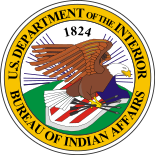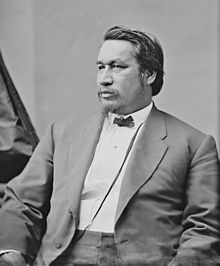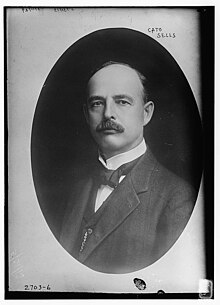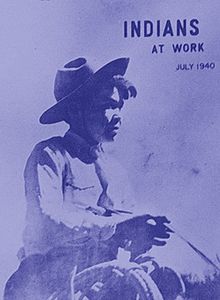
Seal of the U.S. Bureau of Indian Affairs
| |

Flag of the U.S. Bureau of Indian Affairs
| |
| Agency overview | |
|---|---|
| Formed | March 11, 1824 |
| Preceding agency |
|
| Jurisdiction | Federal Government of the United States |
| Headquarters | Main Interior Building 1849 C Street, NW Washington, D.C., U.S. 20240 |
| Employees | 8,700 (FY08) |
| Agency executives |
|
| Parent agency | United States Department of the Interior |
| Website | www.BIA.gov |
The Bureau of Indian Affairs (BIA) is an agency of the federal government of the United States within the U.S. Department of the Interior. It is responsible for the administration and management of 55,700,000 acres (225,000 km2) of land held in trust by the United States for Native Americans in the United States, Native American Tribes and Alaska Natives.
The BIA is one of two bureaus under the jurisdiction of the Assistant Secretary for Indian Affairs: the Bureau of Indian Affairs and the Bureau of Indian Education, which provides education services to approximately 48,000 Native Americans.
The BIA’s responsibilities originally included providing health care to American Indians and Alaska Natives. In 1954 that function was transferred to the Department of Health, Education, and Welfare (now known as the U.S. Department of Health and Human Services), and it is now known as the Indian Health Service.
Organization
Located in Washington, D.C.,
the BIA is headed by a bureau director who reports to the Assistant
Secretary for Indian Affairs. The current assistant secretary is Tara Sweeney.
The BIA oversees 567 federally recognized tribes through 4 offices:
- Office of Indian Services: operates the BIA’s general assistance, disaster relief, Indian child welfare, tribal government, Indian Self-Determination, and Indian Reservation Roads Program.
- Office of Justice Services (OJS): directly operates or funds law enforcement, tribal courts, and detention facilities on federal Indian lands. OJS funded 208 law enforcement agencies, consisting of 43 BIA-operated police agencies, and 165 tribally operated agencies under contract, or compact with the OJS. The office has seven areas of activity: Criminal Investigations and Police Services, Detention/Corrections, Inspection/Internal Affairs, Tribal Law Enforcement and Special Initiatives, the Indian Police Academy, Tribal Justice Support, and Program Management. The OJS also provides oversight and technical assistance to tribal law enforcement programs when and where requested. It operates four divisions: Corrections, Drug Enforcement, the Indian Police Academy, and Law Enforcement.
- Office of Trust Services: works with tribes and individual American Indians and Alaska Natives in the management of their trust lands, assets, and resources.
- The Office of Field Operations: oversees 12 regional offices; Alaska, Great Plains, Northwest, Southern Plains, Eastern, Navajo, Pacific, Southwest, Eastern Oklahoma, Midwest, Rocky Mountain, and Western; and 83 agencies, which carry out the mission of the Bureau at the tribal level.
History
Ely S. Parker was the first Native American to be appointed as Commissioner of Indian affairs (1869–1871).
Cato Sells, Commissioner of Indian Affairs, 1913.
Early US agencies and legislation: Intercourse Acts
Agencies to relate to Native Americans had existed in the U.S. government since 1775, when the Second Continental Congress created a trio of Indian-related agencies. Benjamin Franklin and Patrick Henry were appointed among the early commissioners to negotiate treaties with Native Americans to obtain their neutrality during the American Revolutionary War.
Office of Indian Trade (1806–1822)
In 1789, the U.S. Congress placed Native American relations within the newly formed War Department. By 1806 the Congress had created a Superintendent of Indian Trade, or "Office of Indian Trade" within the War Department, who was charged with maintaining the factory trading network of the fur trade. The post was held by Thomas L. McKenney from 1816 until the abolition of the factory system in 1822.
The government licensed traders to have some control in Indian territories and gain a share of the lucrative trade.
Bureau of Indian Affairs (1824–present)
The abolition of the factory system left a vacuum within the U.S. government regarding Native American relations. The Bureau of Indian Affairs was formed on March 11, 1824, by Secretary of War John C. Calhoun, who created the agency as a division within his department, without authorization from the United States Congress. He appointed McKenney as the first head of the office, which went by several names. McKenney preferred to call it the "Indian Office", whereas the current name was preferred by Calhoun.
In 1832 Congress established the position of Commissioner of Indian Affairs. In 1849 Indian Affairs was transferred to the U.S. Department of the Interior. In 1869, Ely Samuel Parker was the first Native American to be appointed as commissioner of Indian affairs.
One of the most controversial policies of the Bureau of Indian
Affairs was the late 19th to early 20th century decision to educate
native children in separate boarding schools,
with an emphasis on assimilation that prohibited them from using their
indigenous languages, practices, and cultures. It emphasized being
educated to European-American culture.
20th century
1940 Indians at Work magazine, published by the Office of Indian Affairs, predecessor agency to the Bureau of Indian Affairs.
The bureau was renamed from Office of Indian Affairs to Bureau of Indian Affairs in 1947.
With the rise of American Indian activism
in the 1960s and 1970s and increasing demands for enforcement of treaty
rights and sovereignty, the 1970s were a particularly turbulent period
of BIA history. The rise of activist groups such as the American Indian Movement (AIM) worried the U.S. government; the FBI responded both overtly and covertly (by creating COINTELPRO and other programs) to suppress possible uprisings among native peoples.
As a branch of the U.S. government with personnel on Indian reservations, BIA police were involved in political actions such as:
- The occupation of BIA headquarters in Washington, D.C. in 1972: On November 3, 1972, a group of around 500 American Indians with the AIM took over the BIA building, the culmination of their Trail of Broken Treaties walk. They intended to bring attention to American Indian issues, including their demands for renewed negotiation of treaties, enforcement of treaty rights and improvement in living standards. They occupied the Department of Interior headquarters from November 3 to November 9, 1972.
- Feeling the government was ignoring them, the protesters vandalized the building. After a week, the protesters left, having caused $700,000 in damages. Many records were lost, destroyed or stolen, including irreplaceable treaties, deeds, and water rights records, which some Indian officials said could set the tribes back 50 to 100 years.
- The Wounded Knee Incident of 1973, where activists at the Pine Ridge Indian Reservation occupied land for more than two months.
- The 1975 Pine Ridge shootout (for which Leonard Peltier was convicted of killing two FBI agents).
The BIA was implicated in supporting controversial tribal presidents, notably Dick Wilson, who was charged with being authoritarian; using tribal funds for a private paramilitary force, the Guardians of the Oglala Nation
(or "GOON squad"), which he employed against opponents; intimidation of
voters in the 1974 election; misappropriation of funds, and other
misdeeds.
Many native peoples continue to oppose policies of the BIA. In
particular, problems in enforcing treaties, handling records and trust
land incomes were disputed.
21st century
In 2013 the Bureau was greatly affected by sequestration funding cuts of $800 million, which particularly affected the already-underfunded Indian Health Service.
Legal issues
Employee overtime
The Bureau of Indian Affairs has been sued four times in class action overtime lawsuits brought by the Federation of Indian Service Employees, a union
which represents the federal civilian employees of the Bureau of Indian
Affairs, the Bureau of Indian Education, the Assistant Secretary of
Indian Affairs and the Office of the Special Trustee for Indian Affairs.
As of 2012 the union is represented by the Law Offices of Snider &
Associates, LLC,
which concentrates in FLSA overtime class actions against the federal
government and other large employers. The grievances allege widespread
violations of the Fair Labor Standards Act and claim tens of millions of dollars in damages.
Trust assets
Cobell vs. Salazar,
a major class action case related to trust lands, was settled in
December 2009. The suit was filed against the U.S. Department of
Interior, of which the BIA is a part. A major responsibility has been
the management of the Indian trust accounts. This was a class-action
lawsuit regarding the federal government's management and accounting of
more than 300,000 individual American Indian and Alaska Native trust
accounts. A settlement fund totaling $3.4 billion is to be distributed
to class members. This is to compensate for claims that prior
U.S. officials had mismanaged the administration of Indian trust assets.
In addition, the settlement establishes a $2 billion fund enabling
federally recognized tribes to voluntarily buy back and consolidate
fractionated land interests.
Mission
The
Bureau is currently trying to evolve from a supervisory to an advisory
role. However, this has been a difficult task as the BIA is known by
many Native Americans as playing a police role in which the
U.S. government historically dictated to tribes and their members what
they could and could not do in accordance with treaties signed by both.
Commissioners and Assistant Secretaries
Heads of the Bureau of Indian Affairs
- 1822-1824 William Clark
- 1824–1830 Thomas L. McKenney
- 1830–1831 Samuel S. Hamilton
- 2002–2004 Terry Virden
- 2004–2005 Brian Pogue
- 2005–2007 Patrick Rasdale
- 2007–2010 Jerold L. Gidner
- 2010–2016 Michael S. Black
- 2016–2017 Weldon Loudermilk
- 2017–present Bryan C. Rice
Commissioners of Indian Affairs
- 1832–1836 Elbert Herring
- 1836–1838 Carey A. Harris
- 1838–1845 Thomas Hartley Crawford
- 1845–1849 William Medill
- 1849–1850 Orlando Brown
- 1850–1853 Luke Lea
- 1853–1857 George Washington Manypenny
- 1857–1858 James W. Denver
- 1858 Charles E. Mix
- 1858–1859 James W. Denver
- 1859–1861 Alfred B. Greenwood
- 1861–1865 William P. Dole
- 1865–1866 Dennis N. Cooley
- 1866–1867 Lewis V. Bogy
- 1867–1869 Nathaniel G. Taylor
- 1869–1871 Ely S. Parker
- 1871–1872 Francis A. Walker
- 1873–1875 Edward Parmelee Smith
- 1875–1877 John Q. Smith
- 1877–1880 Ezra A. Hayt
- 1880–1881 Rowland E. Trowbridge
- 1881–1885 Hiram Price
- 1885–1888 John D. C. Atkins
- 1888–1889 John H. Oberly
- 1889–1893 Thomas Jefferson Morgan
- 1893–1897 Daniel M. Browning
- 1897–1904 William Arthur Jones
- 1904–1909 Francis E. Leupp
- 1909–1913 Robert G. Valentine
- 1913–1921 Cato Sells
- 1921–1929 Charles H. Burke
- 1929–1933 Charles J. Rhoads
- 1933–1945 John Collier
- 1945–1948 William A. Brophy
- 1948–1949 William R. Zimmerman (acting)
- 1949–1950 John R. Nichols
- 1950–1953 Dillon S. Myer
- 1953–1961 Glenn L. Emmons
- 1961 John O. Crow (acting)
- 1961–1966 Philleo Nash
- 1966–1969 Robert L. Bennett
- 1969–1972 Louis R. Bruce
- 1973–1976 Morris Thompson
- 1976–1977 Dr. Benjamin Reifel
Assistant Secretaries of the Interior for Indian Affairs
- 1977–1978 Forrest Gerard
- 1979–1981 William E. Hallett
- 1981–1984 Kenneth L. Smith
- 1985–1989 Ross Swimmer
- 1989–1993 Eddie Frank Brown
- 1993–1997 Ada E. Deer
- 1997–2001 Kevin Gover
- 2001 James H. McDivitt (acting)
- 2001–2003 Neal A. McCaleb
- 2003–2004 Aurene M. Martin (acting)
- 2004–2005 Dave Anderson
- 2005–2007 Jim Cason (acting)
- 2007–2008 Carl J. Artman
- 2008–2009 George T. Skibine (acting)
- 2009–2012 Larry Echo Hawk
- 2012 Donald "Del" Laverdure (acting)
- 2012–2015 Kevin K. Washburn
- 2016–2017 Lawrence S. Roberts (acting)
- 2017 Michael S. Black (acting)
- 2017–2018 John Tahsuda (acting)
- 2018–present Tara Sweeney



